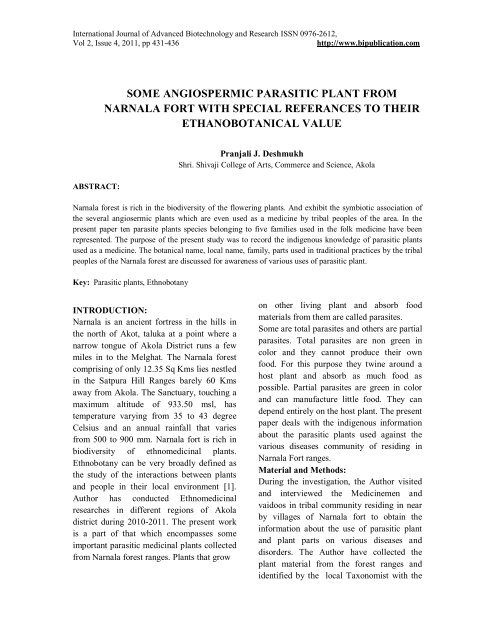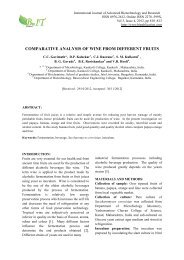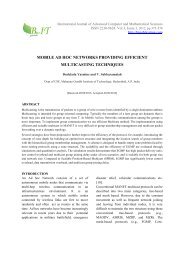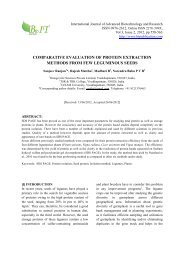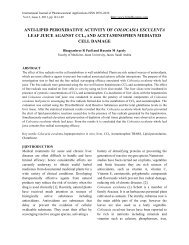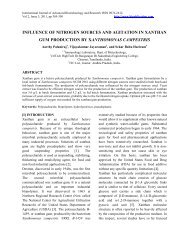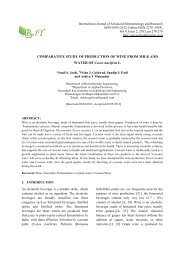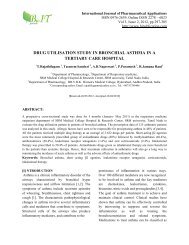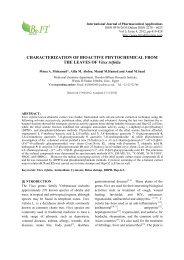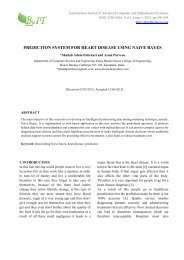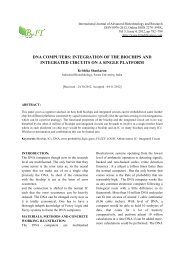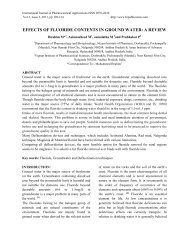431-436 - BioIT international Journals
431-436 - BioIT international Journals
431-436 - BioIT international Journals
Create successful ePaper yourself
Turn your PDF publications into a flip-book with our unique Google optimized e-Paper software.
International Journal of Advanced Biotechnology and Research ISSN 0976-2612,<br />
Vol 2, Issue 4, 2011, pp <strong>431</strong>-<strong>436</strong><br />
http://www.bipublication.com<br />
SOME ANGIOSPERMIC PARASITIC PLANT FROM<br />
NARNALA FORT WITH SPECIAL REFERANCES TO THEIR<br />
ETHANOBOTANICAL VALUE<br />
ABSTRACT:<br />
Pranjali J. Deshmukh<br />
Shri. Shivaji College of Arts, Commerce and Science, Akola<br />
Narnala forest is rich in the biodiversity of the flowering plants. And exhibit the symbiotic association of<br />
the several angiosermic plants which are even used as a medicine by tribal peoples of the area. In the<br />
present paper ten parasite plants species belonging to five families used in the folk medicine have been<br />
represented. The purpose of the present study was to record the indigenous knowledge of parasitic plants<br />
used as a medicine. The botanical name, local name, family, parts used in traditional practices by the tribal<br />
peoples of the Narnala forest are discussed for awareness of various uses of parasitic plant.<br />
Key: Parasitic plants, Ethnobotany<br />
INTRODUCTION:<br />
Narnala is an ancient fortress in the hills in<br />
the north of Akot, taluka at a point where a<br />
narrow tongue of Akola District runs a few<br />
miles in to the Melghat. The Narnala forest<br />
comprising of only 12.35 Sq Kms lies nestled<br />
in the Satpura Hill Ranges barely 60 Kms<br />
away from Akola. The Sanctuary, touching a<br />
maximum altitude of 933.50 msl, has<br />
temperature varying from 35 to 43 degree<br />
Celsius and an annual rainfall that varies<br />
from 500 to 900 mm. Narnala fort is rich in<br />
biodiversity of ethnomedicinal plants.<br />
Ethnobotany can be very broadly defined as<br />
the study of the interactions between plants<br />
and people in their local environment [1].<br />
Author has conducted Ethnomedicinal<br />
researches in different regions of Akola<br />
district during 2010-2011. The present work<br />
is a part of that which encompasses some<br />
important parasitic medicinal plants collected<br />
from Narnala forest ranges. Plants that grow<br />
on other living plant and absorb food<br />
materials from them are called parasites.<br />
Some are total parasites and others are partial<br />
parasites. Total parasites are non green in<br />
color and they cannot produce their own<br />
food. For this purpose they twine around a<br />
host plant and absorb as much food as<br />
possible. Partial parasites are green in color<br />
and can manufacture little food. They can<br />
depend entirely on the host plant. The present<br />
paper deals with the indigenous information<br />
about the parasitic plants used against the<br />
various diseases community of residing in<br />
Narnala Fort ranges.<br />
Material and Methods:<br />
During the investigation, the Author visited<br />
and interviewed the Medicinemen and<br />
vaidoos in tribal community residing in near<br />
by villages of Narnala fort to obtain the<br />
information about the use of parasitic plant<br />
and plant parts on various diseases and<br />
disorders. The Author have collected the<br />
plant material from the forest ranges and<br />
identified by the local Taxonomist with the
SOME ANGIOSPERMIC PARASITIC PLANT FROM NARNALA FORT<br />
help of flora of Maharashtra (MS) and flora<br />
of Marathwada (Naik 1986). The specimen<br />
vouchers of collected plants were deposited<br />
in Department of Botany, Shri Shivaji<br />
College Akola. The collected Ethnomedicinal<br />
information was thus interpreted in the light<br />
of recent researches and presented in this<br />
paper.<br />
Observations and Discussion:<br />
The present paper deals with Ethnomedicinal<br />
uses of 10 parasitic plant species from 5<br />
families. The botanical Name, family, parts<br />
use and disease on which the medicine is<br />
given, and modes of administration are given.<br />
Although above plants are common and<br />
ethnomedicinally investigated from various<br />
regions of Indian subcontinent, the present<br />
study is focused mostly on the view of<br />
ethnomedicines of tribal community which<br />
live in Narnala forest ranges. This area is<br />
lacking proper health care systems rendered<br />
by Government. During the investigation,<br />
authors have collected about several different<br />
plant species of which only 20 parasitic<br />
plants have presented here. The collected<br />
indigenous information is mostly found true<br />
and analogous to the reports of [2],<br />
[3].However, the present study needs further<br />
phytochemical investigation which might<br />
prove beneficial for improving the life style<br />
of Narnala fort tribal peoples and to enrich<br />
the basic researches leading modern<br />
medicinal biology. Plants have been used in<br />
traditional medicine for several thousand<br />
years [4]. Drugs obtained from plant are<br />
believed to be much safer and exhibit a<br />
remarkable efficacy in the treatment of<br />
various ailments [5]. Plants have always been<br />
the source of medicines and have many uses<br />
to mankind. According to some earlier<br />
workers [6-8].<br />
1. Cuscuta reflexa Roxb.<br />
Vernacular Name :. Amar-bel, Amar-vel.<br />
Family: Cuscutaceae<br />
Locality: Narnala Fort<br />
Habitat: Occasional on bushes.<br />
Description:<br />
Stem parasites with greenish-yellow, leafless,<br />
twining and hanging pale yellow, fleshy<br />
stems. Flowers white or creamy-white,<br />
solitary or in umbellate clusters in short<br />
racemes. Capsules globose 0.5-0.8 cm across,<br />
glabrous, circumsessile near the base.<br />
Ethnomedicinal uses:<br />
The decoction of seeds in high doses causes<br />
abortion. Plant paste is applied on swollen<br />
testicles (Banjara). Bhils take orally the<br />
decoction of stem (30 ml) to cure jaundice,<br />
urinary disorder and stomacache. Plant paste<br />
applied on the scalp to prevent hair<br />
fall.Andh: Tribals take orally the decoction<br />
of stem to cure diarrhoea, cholera and<br />
asthma, fever, cough and cold.<br />
2. Viscum verrocosum<br />
Family: LORANTHACEAE<br />
Vern. Name: Hadjod, Harjor.<br />
Locality : Narnala Fort<br />
Habitat : Obligate semi-parasite on<br />
Boswellia serrata Roxb. and on other trees.<br />
Description: dichotomously branched,<br />
pendulous; branches articulated, yellowish-<br />
Pranjali J. Deshmukh 432
SOME ANGIOSPERMIC PARASITIC PLANT FROM NARNALA FORT<br />
green, longitudinally furrowed, narrow at<br />
both ends. Flowers minute in axillary<br />
clusters. Berries 0.1-0.5 cm across, globose,<br />
smooth, greenish-yellow.<br />
Ethnomedicinal Significance:<br />
Andh: Paste of shade dried powder of the<br />
plant with water is applied on the chest to cure<br />
swellings, intense burning sensation and<br />
difficulty in breathing. Bhil: Paste prepared<br />
from the entire dried plant is applied to heal<br />
fractured bone, dislocation and cancerous<br />
wounds.<br />
3. Alectra thomsoni Hook.<br />
to scales, oblong. 2.5-6 mm long, obtuse,<br />
pasing upward into bracts. Flowers 5-7 mm<br />
long, in terminal, lax-flowered, spicate<br />
racemes reaching 25 cm long; bracts minute;<br />
pedicels slender, 4-S mm long. Calyx<br />
hemispheric. 3-4 mm long; teeth broadly<br />
triangular, acute. Corolla yellow with red<br />
venation; tube short; limb oblique, 5-lobed;<br />
lobes spreading, ovoid-orbicular, obtuse.<br />
Stamens 4; anthers touching in pairs; cells<br />
parallel<br />
Ethnomedicinal Significance:<br />
The flowers and roots (haustoria) of<br />
A.thomsoni have been used by rural people i<br />
to dye cloths and other textiles. a golden<br />
yellow dye is extracted which is used for<br />
colouring wood. In traditional medicine leaf<br />
sap is taken to hasten childbirth and plant ash<br />
mixed with castor oil is rubbed onto scars<br />
caused by leprosy. A root decoction is used<br />
as a mouthwash against toothache and given<br />
to small children to treat diarrhoea.<br />
4. Dendropthae falcata (L.f.)<br />
Family: LORANTHACEAE<br />
Vern, Name: Dhawada bandha (K), Banda<br />
Family: SCROPHULARIACE<br />
Vern.Name: Alectra<br />
Locality : Narnala Fort<br />
Habitats: Rare, along stream-banks in hill<br />
forests, parasitic on roots of Acanthaceous<br />
plants.<br />
Description:<br />
Erect root parasitic herbs, 15-30 cm tall; stem<br />
rigid, flexuous, scaberulous. Leaves reduced<br />
(H), Vanda (M).<br />
Locality : Narnala Fort<br />
Habitat : Commonly met during the cold<br />
and hot season on a good number of host<br />
plants such as Buchanania lanzan, Pongamia<br />
pinnata. Holoptelia intergrifolia.<br />
Description :<br />
The large, branched, partial parasite growing<br />
on trunk of the trees. Leaves simple,<br />
Pranjali J. Deshmukh 433
SOME ANGIOSPERMIC PARASITIC PLANT FROM NARNALA FORT<br />
alternate, variable in shape, leathery, oblong,<br />
obtuse with cuneate at the base. Flowers<br />
orange in axillary raceme, bracts minute,<br />
ovate. Calyx tomentose, shortly five lobed.<br />
Corolla tube curved, lobes five, reflexed.<br />
Stamens exerted. Style quadrangular, stigma<br />
knob shaped. Fruit berry 1 cm long, black,<br />
when riped, oblong.<br />
Ethnomedicinal significance:<br />
Bark of this plant is used in impotency by<br />
Gond tribes. Korku tribes applied juice in<br />
leucoderma and other skin infection. Korku<br />
tribes also use the decoction of bark in<br />
asthma and to regulate menstrual cycle in<br />
women.<br />
5. Santalum album L.<br />
Family: SANTALACEAE<br />
Vern. Name : Safed Chandan (H), Chandan<br />
exserted. Fruit drupe, globose, purpleblack.<br />
(The yellowish-brown strongly- scented heart<br />
wood constitute the well-known sandal<br />
wood).<br />
Ethnomedicinal significance:<br />
Leaf extract of this plant used in dysentery by<br />
the local tribes. Wood-ground up with water<br />
into paste applied to the temples in headache,<br />
fever and local inflammation and in skin<br />
diseases. Wood also used in bilious fever.<br />
6.Striga gesnerioides<br />
Family:SCROPHULARIACE<br />
Varn.Name: : cowpea witchweed, tobacco<br />
(M).<br />
Locality : Narnala Fort<br />
Habitat : Common in forest, also planted in<br />
gardens.<br />
Description :<br />
A glabrous perennial everygreen small trees<br />
with drooping branches, bark smooth<br />
aromatic. Leaves simple, alternate,<br />
lanceolate, acute, entire, petiolate, shining.<br />
Flowers small in axillary pedunculate cyme,<br />
greenish, crimson, inodorous, perianth<br />
campanulate with 4 valvate segment, disc,<br />
lobed and thick. Stamen 4 polyandrous,<br />
witchweed<br />
Locality: Narnala fort<br />
Habitat: parasitizes on sorghum, sugarcane,<br />
rice, legumes<br />
Description:<br />
S. gesnerioides of typical Scrophulariaceous<br />
form, are borne in opposite pairs or<br />
alternately in a terminal leafy inflorescence.<br />
The underground part of the stem is purple,<br />
cylindrical, somewhat thicker than the aerial<br />
part and 2.5-7.5 cm long. The roots are white<br />
and closely attached to the host roots by<br />
haustoria .<br />
Ethnomedicinal significance:<br />
The sap of Srtiga gesnerioides is used to dye<br />
skins blue-blank in mali.<br />
Pranjali J. Deshmukh 434
SOME ANGIOSPERMIC PARASITIC PLANT FROM NARNALA FORT<br />
The flower yield a pink colour which can be<br />
used for painting. As fodder S. Gesnerioides<br />
is useless, cattle will not graze it and only<br />
camels browse it reluctantly when nothing<br />
else is available.<br />
The stem is said to be used as toothbrush.<br />
In traditional medicine, the powdered plant is<br />
sprinkled on wounds.<br />
7.Buchnera hispida<br />
Family: SCROPHULARIACEAE<br />
Varn. Name: wuta wuta<br />
8.Sophubia delphinifolia<br />
Family: SCROPHULARIACEAE<br />
Varn. Name: sophia<br />
Locality: Narnala fort<br />
Habitat: a facultative root parasite of grasses<br />
and graminaceous crops, mostly on sorghum<br />
vulgare<br />
Description: Facultative hemiparasitic, erect<br />
annual herb up to 1 m tall with simple or<br />
branched, hairy or scabrid stem. Leaves in a<br />
rosette at base in young plants, alternate on<br />
the stem, simple, sessile, rigid-hairy to<br />
scabrid; stipules absent; rosette leaves<br />
elliptical to almost circular,, margin entire,<br />
Fruit an ovoid capsule up to 5.5 mm × 3 mm,<br />
many-seeded. Seeds longitudinally striate.<br />
Ethnomedicinal significance:<br />
The whole plant of B. Hispida turns blueblack<br />
if bruised and becomes black after<br />
drying. Thedried plant is used as source of<br />
black dye for skin and textile.dried powder is<br />
mixed with caster oil and applied externally<br />
to scabies eczema.<br />
Locality: : Narnala fort<br />
Habitat: Occassional, along the margins of<br />
ponds,lake and in moist places among<br />
grasses.<br />
Description:<br />
Errect, glabrous, semi parasite, herb, stem 4-<br />
angled ribbed. Leaves sessile,pinnatisect,<br />
segment filiform. Flowers purplish or<br />
pinkish, large, showy, solitary, axillary or in<br />
terminal racemose, capsule, globuse, many<br />
seeded.<br />
Ethnomedicinal significance:<br />
Its juice is reported to possess healing<br />
properties for sores causedbymoisture and is<br />
alsoreportedtobe an abortifacient.<br />
References:<br />
1. Arora, R. K. (1997): Ethnobotany and its<br />
role in the conservation and use of plant<br />
genetic resources in India. Ethnobotany. 9: 6-<br />
15.<br />
2. Bhogaonkar, P. Y. and Deokule, S. (2002):<br />
Some useful ethnomedicinal plants of Korku<br />
of Melghat region (MS), Ethnobotany. 12 (1-<br />
2): 16-19.<br />
3. Ibrar, M. (2002): Responsibilities of<br />
ethnobotanists in the field of medicinal<br />
plants. In Proceeding of Workshop on<br />
Curriculum Development in Applied<br />
Ethnpbotany. Ethnobotany Project, WWF<br />
Pakistan, 34-D/2, pp :16-20.<br />
Pranjali J. Deshmukh 435
SOME ANGIOSPERMIC PARASITIC PLANT FROM NARNALA FORT<br />
4. Pei, S.J. (2001). Ethnobotanical approaches<br />
of traditional medicine studies some<br />
experiences fromAsia, 39:74-79.<br />
5. Siddhiqui, M.A.A. John, A.Q; Paul, T.M;<br />
(1995). Status of some important medicinal<br />
and aromatic plants of Kashmir Himalaya, 8:<br />
134-139.<br />
6. Jain, S.K. (1965). Medicinal plants lore of<br />
tribals of Bastar,Econ.,Bot ., 19:236-250.<br />
7. Kirtikar, K.R. and Basu, B.D. (1999). Indian<br />
Medicinal Plants. I-IV. Vols. International<br />
Book Distributors, Booksellers and<br />
Publishers, Dehra Dun.<br />
8. Nadkarni, K.M. (2001). Indian plants and<br />
drugs with their medicinal properties and<br />
uses. Asiatic publishing House, NewDelhi.<br />
Pranjali J. Deshmukh <strong>436</strong>


